by Sarah Hooper and Bill Zoellick
It’s a new year! In this issue, we bring you up to date on what has happened since early December in work with our local school district (RSU 24), the town of Gouldsboro, and others. Students have finished collecting their data about green crabs, we are working with Gouldsboro toward creating a community shellfish research facility, and we’ve been working with the Downeast Institute to find ways to expand CSI-Maine to other schools and communities.
Crab Data!
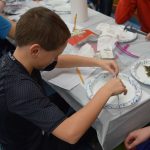
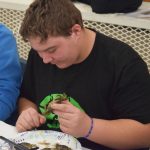
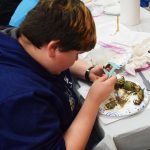
On December 18, just before the holiday break, middle school students from three K-8 schools traveled to Sumner Memorial High School to measure and classify all the crabs that they captured during their fieldwork in September.
The students processed 117 crabs that morning. For each crab, they determined the species, color, gender and, for female crabs, noted whether it was egg-bearing or not. They also recorded the carapace width for each crab. The smallest crab measured 13 mm across (about a half-inch); the largest was 80 mm (more than 3 inches!).
The students measured and classified each crab twice. Just this week, students at Peninsula School, which had not participated in the December 18 event, processed the crabs once again. Having three sets of data will provide students with the opportunity to decide how they can use these different data sets to improve the accuracy of the answers they will provide.
Crab Questions!
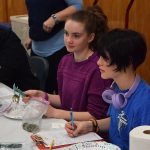
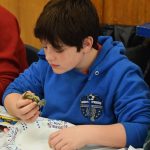
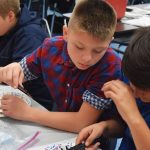
After the students measured and categorized the crabs, we asked each of them to write down three questions that they would like to investigate this spring. Once all had their questions, we asked each of them to pair up with a student from another school and to interview each other about their questions. The pairs then had the opportunity to share questions that they thought were especially interesting. Here are some of their questions:
-
Do crabs of the same sex hang out with each other?
-
Do some seaweed patches have more crabs than others?
-
How territorial are they?
-
Would we get really different results in another cove?
-
How does tide level and the location of the seaweed patch affect crab size and numbers?
These are all questions that the students can begin to answer by working with the data over the coming months. We are sure that, as always happens when working with data, more questions will arise. Some will be questions that students can explore by bringing crabs into the classrooms in small aquariums, enabling them to test ideas about territoriality, how crab size matters, how the presence of food matters, and more. Schoodic Institute will help teachers help students make sure that they are not only asking well-structured questions, but also developing good plans for answering those questions and then reporting out on what they find.
Gouldsboro Clam R&D
Back in November, we wrote about our work with high school students and the town of Gouldsboro aimed at capturing small, first-year clams that the town can then “overwinter” and use as seed clams out on the clam flats the following year. The rationale behind this initiative is that Gouldsboro, like other towns, has been having good success in using seed clams to increase the number of harvestable soft-shell clams, but has also found that it is difficult to sustain such work, given the cost of seed clams (about $25/thousand). However, very small, newly hatched clams are available for only about $8/thousand. So, if the town could develop a way to grow these clams out during their first summer and then keep them alive during the following winter, it might be able to expand clam seeding and make it sustainable.
Our colleagues at the Downeast Institute (DEI) can help us with getting clams to grow over their first summer without having them get eaten by birds, crabs, and other predators, but the problem of finding a low-cost, reliable way to manage the overwintering is a more difficult problem. We know of people who are solving similar problems with oysters and other shellfish, so we are pretty sure that there is a path to success here, but there is also a lot to figure out.
In early December, Bill accompanied Mike Pinkham, Gouldsboro’s shellfish warden, to a meeting with our friends at DEI to begin thinking about the shape of a solution. Along with that thinking, some pieces began to come together. On December 12, the Gouldsboro Select Board voted to provide the shellfish committee with the use of some town-owned shorefront property that could become the site of a small shellfish research facility to support investigations into how to overwinter clams with high survival rates and, we hope, low costs in terms of energy and other inputs. To support this, Bill and Sarah began work with the Pathways program at Sumner to bring students on board to help with the design of this work and, next fall, in operating and maintaining the facility. (We see it as a facility that provides learning opportunities as well as seed clams and other outputs that the town needs.) We have our first meeting with students about this program tomorrow.
Schoodic Institute and the town are also collaborating on the preparation of a proposal to the Maine Shellfish Restoration and Resilience Project that we hope will provide funds needed for site work, a small building, equipment and the other things we need to get the facility up and running by this fall.
We are excited about this work. It not only brings the community and the schools together around important scientific work that can make a difference to the community, but also has the potential to develop and demonstrate techniques that other communities can use to sustain and expand their local fisheries.
Robert Hill Memorial Fund Update
Thanks to all of you who made a contribution to the fund to help out the family of clam fisherman Robert Hill, who drowned while harvesting clams on November 7. To date, we have raised $1,975. Thank you, thank you, thank you.
More …
Our final bit of news for this issue is that the Downeast Institute asked us whether we would join them in a proposal to expand the work we have been doing here to other Downeast communities. The idea is to help more schools and towns link up their resources and capacities to address the challenges that the fishery is encountering as the Gulf of Maine warms up and changes. Of course, we said YES. Bringing the knowledge, human capacity, and energy of students and schools to bear upon local issues clearly makes good sense, not just for student learning, but also in terms of the choices towns can make. But, having done this work for a while now, we also have a good understanding of why such collaboration between community and schools does not just happen on its own. We are excited about the opportunity to apply what we have learned in other communities and to other problems.